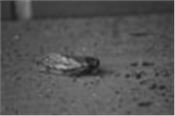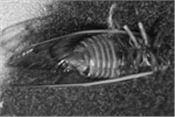|
Periodical Cicada: Guardians Of Time
DR. RIC BESSIN, DR. RAUL VILLANUEVA AND DANIEL BECKER
PRINCETON, KY.
One of the more spectacular entomological events is the emergence of millions of periodical cicadas. What makes this event so unusual is that it occurs so infrequently, each brood emerging every 13 or 17 years. Depending on where one lives, a person may be in high school before experiencing a periodical cicada emergence. Early settlers to this country referred to these insects as locusts, in reference to plagues of locusts. A large emergence of cicadas can provide a striking visual image, and the sounds they produce can be deafening.
Periodical Cicadas vs. Annual Cicadas
Periodical cicadas are different from the dog-day cicadas that emerge each summer. Periodical cicadas emerge in May and are active in June, dog-day cicadas emerge in July. Periodical cicadas have black bodies, red eyes, and red-orange wing veins in two pairs of clear wings that are held roof-like over the abdomen. These clumsy fliers often stay in the upper canopy of trees while they are active from late April thru June. Encounters with periodical cicadas can be unnerving to some but these insects cannot sting nor do they harm humans, livestock, or pets.
Cicada Broods and Emergence
Also unusual for this insect (although it is actually a group of closely related species) is the extended life cycle and the synchronized emergence every 13 or 17 years. It is thought that cicadas do this to help avoid predator populations from synchronizing with their emergence and the cicadas can then overwhelm predators with their sheer numbers. There are 15 broods of periodical cicadas in the United States and six of those occur in Kentucky, although two of those broods are very limited in numbers and location relative to other broods. The table below shows the broods we have in Kentucky and when and where they will emerge.
We can predict when the broods will emerge decades into the future, just like clockwork. However, there are some individuals or partial broods that emerge on off-cycle years. A few individuals emerge a year early, and several 17-year broods in recent years have portions that emerge after 13 years. There is a 4-year acceleration hypothesis to explain why the latter emerge early. While this is not a periodical cicada year for Kentucky, we have had some reports from Louisville and Daviess, Caldwell, and Lyon counties in western Kentucky. This may be a 4-year early emergence from Brood XIX or a year early emergence from Brood X.
The cicadas found in western Kentucky are confirmed specimens of Brood XIX, Magicicada tredecim (Figure 2) (identified by Dr. Gene Kritsky, School of Behavioral and Natural Sciences, Mount St. Joseph University). He believes that these may be emerging in small numbers, thus it may not be a threatening population for ornamental, grape, apple, or peach crops.
Periodical Cicada Impact on Plants
Periodical cicadas are pests of many trees and woody ornamentals. These insects can cause problems in orchards, vineyards, nurseries, and home and commercial landscapes. Physical injury or “flagging” occurs after females slit twigs to insert batches of eggs. Twigs break at these weak spots and are left to dangle, turn brown, and die. This “pruning” is not a serious problem for large trees but can adversely affect the developing structure of small trees. A more subtle impact can occur several years later as growing nymphs remove sap from roots. Some nursery and orchards will delay planting in cicada years until after the activity has ended. After egg hatch, cicada nymphs search and colonize tree roots where they will feed for the next 13 or 17 years.
Continued monitoring will be required over the coming weeks to assess populations and potential for damage in order to decide if pesticide application is necessary. Obviously, if a substantial emergence occurs, significant control measures must be applied to protect potential plant host that might be affected by cicadas. ∆
DR. RIC BESSIN AND DR. RAUL VILLANUEVA: Entomology Extension Specialists, University of Kentucky
DANIEL BECKER: Horticulture Extension Associate for Vegetables/Fruit, University of Kentucky


Brood Number Cycle of Emergence Next emergence Location in Kentucky
X 17 year 2021 Along Ohio River and SE KY counties
XIX 13 year 2024 Pennyrile and Green River Areas; low risk in other areas
XIV 17 year 2025 Most of state east of Purchase Area
I 17 year 2029 Smaller emergence in parts of Harlan, Lecher, Martin, and Pike Counties
XXIII 13 year 2031 West of I-65
V 17 year 2033 Smaller emergence in parts of Boyd, Greenup, and Lawrence Counties
|
|